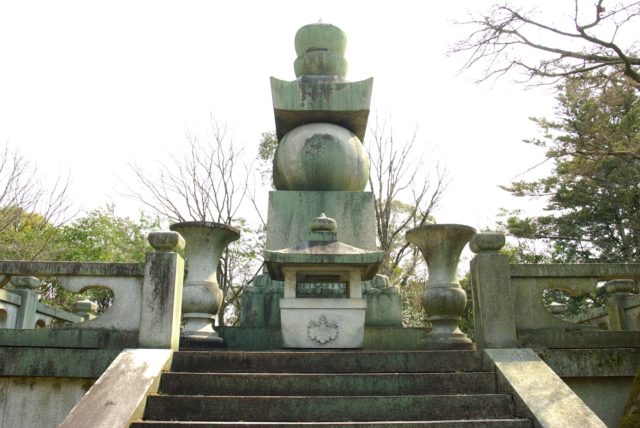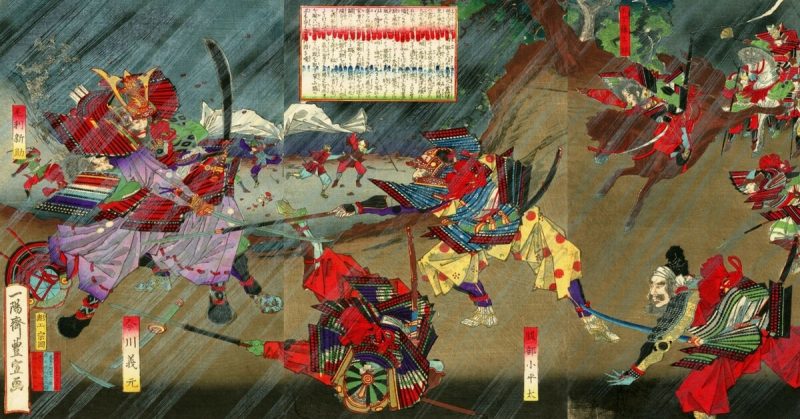The second in a series of three warlords who united a divided Japan, Toyotomi Hideyoshi led the nation during the late 16th century. He is often referred to as the Napoleon of Japan, but it might be fairer to reverse that description. Hideyoshi’s successes were 200 years before the French ruler; leaving Napoleon as the Hideyoshi of Europe.
Rise Under Nobunaga
The 15th and 16th centuries saw a change in Japanese warfare. As in Europe, armies grew increasingly large, and troops were equipped with mass produced weapons.
In Japan, it led to wars less focused on the samurai, the country’s elite warriors. Vast numbers of peasant soldiers, previously despised by their rulers, were recruited. They were called ashigaru, meaning light feet. The name derived from the fact they were not weighed down with armor, which their leaders could not afford. Their weapons were spears and swords which were inferior to the high-quality swords that were the symbol of the samurai.
Born in 1539, Toyotomi Hideyoshi was the son of a woodcutter. As a peasant, he began his military career as an ashigaru, a lowly warrior in the armies of the great Oda Nobunaga. Hideyoshi was an incredibly gifted fighter. Unlike most leaders of samurai armies, he rose to prominence by skill alone.
In 1582, he was one of Nobunaga’s leading commanders. As Nobunaga fought to reunite a fractured country under his leadership, Hideyoshi was laying siege to Takamatsu castle. He asked his master for reinforcements.
It inadvertently led to Nobunaga’s downfall. Hurrying to send troops to aid Hideyoshi, he left himself exposed. Ambushed by one of his own generals, Nobunaga became trapped in a temple in Kyoto. As the building burned down around him, he committed suicide.
Taking Control
Oda Nobunaga had not inherited a position of power such as an emperor or shogun. He had gained control through force of will and strength of arms. In his absence, squabbles erupted over who would inherit his position and what the policy of the government would be.
Hideyoshi emerged from the fray as Japan’s new leader.
His first act was to avenge the death of his former master. Gathering his troops, he sought out Akechi Mitsuhide, the man who had betrayed and destroyed Nobunaga. He defeated the traitor at the Battle of Yamazaki. The victory was so sudden that Akechi is known as the Thirteen Day Shogun, a measure of how briefly he ruled.
Almost everyone with any influence had opposed Hideyoshi’s attempt to seize power. He outmaneuvered and defeated them politically and militarily. At the Siege of Kameyama, he became the first samurai commander to take a castle by mining. At Shizugataka, he used a night advance to catch his enemies by surprise. At the Battle of Nagakute, he so impressed a key opponent that they became allies.
He made Nobunaga’s inheritance his own.
The Castle Builder
Hideyoshi is remembered as the castle builder. Starting with the castle at Osaka, he constructed substantial fortifications that stood the test of time. A sloping stone base leading up to a vast white-walled fortress became a lasting symbol of his rule.
The irony of his reputation is that he destroyed as many castles as he built. Control of castles was vital to ruling the country, so Hideyoshi sought to create a monopoly. He tore down the fortresses of his opponents while building bigger, stronger ones of his own.

Ruling a Divided Country
For many years, Japan had been divided. Rival warlords had fought for power, but Hideyoshi tried to end the fighting.
In 1587, he decreed that anyone who was not a samurai was to be disarmed. The event, known as the Great Sword Hunt, saw thousands of swords collected. They were melted down to make nails and bolts for a magnificent statue of the Buddha.
There was an irony to his decree. By disarming peasants, Hideyoshi cut off the route to military advancement he had taken.
War continued to play a part in Hideyoshi’s rule. He created highly trained, well-equipped armies and controlled them over great distances. He was the first lord from the Japanese mainland to conquer the other main islands of Shikoku and Kyushu.
Defeating the Hojo
The last clan to hold out against Hideyoshi were the Hojo.
Throughout the wars, the Hojo had defended their power the same way other clans did by maintaining armies of elite samurai and fortresses to which they could retreat in times of crisis. In 1590, they were finally driven back to their last fortress – Odawara.
Odawara was one of the largest and strongest fortresses in Japan. Unlike most fortifications, it had walls made mainly of stone. The Hakone Mountains added to its defenses. Seeing Hideyoshi coming to destroy their base, the Hojo called in all their samurai. They brought them, their followers, and their families from surrounding castles to defend the last bastion.
The siege that followed was immense. 50,000 defenders were inside the walls, while 200,000 besiegers formed a town outside to starve out the occupants. There were only occasional raids interspersing the quiet in which men played games and grew vegetables beneath the shadow of the mountains.
When the fortress finally fell, its lord committed suicide. His territory was given to Tokugawa Ieyasu, who would follow Hideyoshi as leader of Japan.
Korea
In 1592, Hideyoshi looked beyond Japan’s borders. He launched an invasion of Korea.
Better equipped, organized, and led, the Japanese dominated the Koreans on land but it was different at sea. The Korean Admiral Yi Sun Shi used a fleet of heavily armed warships, including turtle boats clad with armored iron plates, to disrupt Japanese supplies and communications. When the Chinese joined the Koreans, the Japanese were forced to retreat.
Hideyoshi tried again, launching a second invasion in 1596 but he died in 1598 with his work of conquest incomplete. Like Napoleon, the wars of Japan’s greatest general ended not in glory but in a moment of failure.
Despite that, he left a strong legacy. A united country, well fortified, with powerful, effective armies.
Source:
Stephen Turnbull (1987), Samurai Warriors
